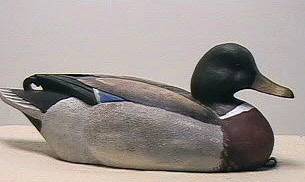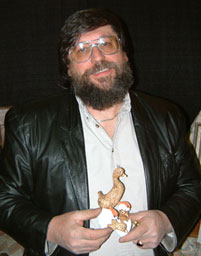
Vince Giannetto wasn’t sure how they got his name. But somebody had passed it along to the New Jersey governor’s office. And last fall they called to ask if Vince could complete a wood carving that would represent New Jersey on the White House Christmas tree. Vince was pretty sure, however, that he could complete the project … a bird indigenous to New Jersey.
After all, bird carving — duck decoys to be specific — is Vince’s passion and business. Getting to the point of representing his home state, required a major, mid-life career change … but you can trace the distinction back to the Delaware River where Vince liked to hunt when he was a teenager.
“My dad wasn’t the type to go buy me a set of decoys,” Vince recalled. “He thought I should be working instead of going off hunting. So, I made my own wooden decoys to hunt over. Then in 1967, I was about 20, a friend who also carved told me about a show up in Babylon, Long Island. In those days, it was just a bunch of duck hunters who got together and put their decoys into a friendly competition. They gave ribbons and winning $50 was a big deal.”
The next year, Vince put a couple of birds into the competition, did well, and then found that there were people out there, collectors, who would actually buy his gunning decoys … for $15 to $20! Vince then carved when he could while he worked for his father’s construction company. He developed his skill by copying some old decoys by the renowned southern New Jersey carver John Fitzpatrick. This firmly grounded him in the Delaware River style of gunning decoys. Using a growing collection of drawknives, rasps and knives, he incorporated the style’s more detailed carving and characteristic raised V to simulate wings on the bird’s back.
At age thirty, he started his own masonry business and for years, he also kept about 8,000 pheasants (yup, the birds). It kept him pretty busy, but he kept carving … winning competitions and developing his reputation. By the time he reached age 40, he was ready to take the plunge into full-time carving.
“I don’t think a human being was made to push concrete around for ever,” he noted. “My back was gone, and my knees were shot. It wasn’t difficult to give up the masonry work, but with five kids and putting them through college, it was a big decision to go into carving full-time. I saved my trowel, figuring I could always go back to it.”
Though he’s never had to go back to it, early on, Vince realized that the decoys alone wouldn’t provide enough income.
“So I got into the wholesale end. And that allowed me to make Santa Clauses, puffins, egrets, and rockers. They don’t follow any tradition, other than being country. I keep them simple, so I can sell them at a fair price. Sure, if I had my druthers, I’d just carve decoys, but it’s fun and it breaks up the monotony.
Some of his best wholesale customers are high-end furniture stores, art galleries, and interior decorators, all of whom move a lot of his carvings.
“I still do all the wholesale carving. If you spend eight hours a day at it, you can produce a lot of things, and having had a construction background, I think I’m used to working harder than some. It’s nothing glamorous, but it keeps me from pushing concrete around all day.”
That compromise paid off and 19 years later, Vince is firmly established as one of the country’s leading decoy carvers. That brings us back to the White House Christmas tree.
“The White House contacted me with the size and weight,” Vince explained. “The only restriction was that it had to hang from a gold ribbon and be a bird native to New Jersey … which covers a lot of birds. I had about two months, and I knew there’d be lots of state birds and eagles, but I ended up choosing baby ducks. I’d first make them for an inventor, who was developing bass fishing lures … bass eat baby duck. I put some rubber feet on the five that were left over, named them after members of my family and started selling them … they were a big hit! They meant more to me than making an American eagle. So, I made up a design, carved it, and sent it to the White House. My wife and I then went down on December 4th for a reception with all the other artists and carvers. Everyone got his or her picture taken in front of the tree with Mrs. Bush. It was a once-in-a-lifetime thing for me. All the birds were put into the Smithsonian collection.”

Vince’s style has evolved over the years. He’s somewhat modernized the Delaware River style, but he still makes them out of the traditional Atlantic white cedar, a tree native to New Jersey.
“Over time, you find certain things you have to do to them for hunting to make them more functional … and of course, they have to be sellable. It’s still a decoy, made of hollow cedar and it has to float … they’ve kept that in the competitions. But they now allow a lot more paint than you need for gunning decoy.”
Today, Vince works out of a converted corncrib studio. He uses a collection of over thirty stuffed birds and books for reference to create his designs on paper. The rough shape is cut out on a band saw, and he now uses a Fordham flexible shaft tool to do most of his carving. The head is cut out separately and carved first. It’s attached with glue and a screw that runs through the body. The body is then carved to match the head and then cut in half so it can be hollowed out for floating. After it’s rejoined, Vince will smooth it out with sandpaper and might do a little knife work for the feathers on the back. Once the eyes have been attached, he paints the bird.
“I use oil paints … same as oil painters They’re easier to blend than acrylics, and as the birds get older the oil develops a patina that people like. It’s just like painting a flat picture, except it’s in three-dimensions and you can’t paint the shadows. When you do to a mallard’s head, you don’t have sun coming from a certain direction, so you create the illusion of iridescence. It’s very difficult. I’ve had a pen of ducks out back for years, and I spend a lot of time watching them and that come back. It takes a lot of observation.”
Most of his ducks sell for about $300. Which might seem kind of low, but Vince wants them to sell.
“It doesn’t take me that much time, and it breaks down into a per-hour rate … whether you’re laying bricks or carving decoys. Some of the guys who carve get up on cloud nine about what wonderful artists they are, but the bottom line is … you’re making a wooden duck. I’m a little more realistic about it.”
Vince still loves to hunt. And each year he makes up a rig of decoys … mostly black ducks, mallards, and a lot of green-wing teal.
“And I use them as much as I can,” Vince laughed, “But since I need the money more than I need the decoy, I often end up selling them. Some collectors would rather have one of the birds I hunted over, rather than the one off the table.”
To see more of Vince Giannetto’s carvings visit his web site.





